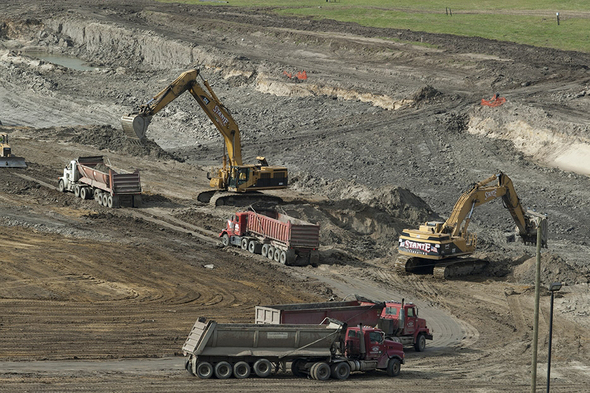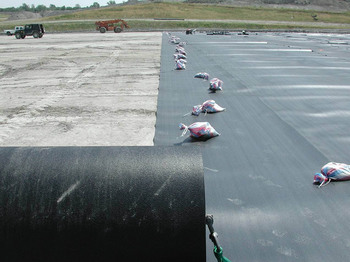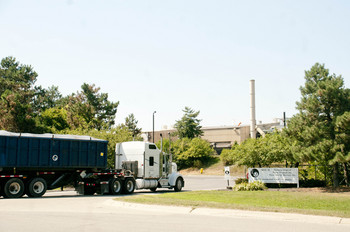Hazardous waste landfill near Willow Run Airport begins expansion

Construction has begun on an expansion of the Wayne Disposal hazardous material landfill.
Photo courtesy of Dwight Cendrowski
A Van Buren Township hazardous waste landfill will expand throughout the next year.
The 500-acre Environmental Quality Wayne Disposal Center, which has operated off the I-94 Service Drive since 1957 and is one of 20 of its kind in the U.S., will utilize the last unused 58 acres it owns to complete the expansion.
The parcel is bordered on three sides by closed landfills and on the west side by the Willow Run Airport. Because of Federal Aviation Administration rules, the landfill cannot expand any higher.
Bob Doyle, EQ's Marketing and Communications Manager, said the Wayne Disposal Center will no longer accept waste after the final parcel is built out, and the facility will then manage what waste is there.
So far, several officials say there has been little opposition to the expansion.
“We’ve got a lot of positive feedback,” Doyle said. “Of course no one wants hazardous waste in their backyard, but I think people know that in the society we live in today this type of waste has to go somewhere.”
When inorganic materials can’t be addressed some other way, Wayne serves as the final option for storage. Doyle added that the volume of hazardous material being dumped or generated by industry has decreased, thus reducing the number of sites like Wayne that are needed.
“Companies are being a lot better (about) being responsible, being sustainable, recycling and re-using,” he said.
Wayne receives inorganic and non-biodegradable waste that is hazardous and doesn’t accept “municipal waste”, such as residential and commercial garbage. The waste it does accept must be solid and often contains heavy metals, pcb’s or residue from incinerators that cannot be broken down.
Doyle highlighted safety precautions Wayne takes and its system for preventing water from leaking into the ground water or aquifer. The waste sits on a roughly 10-foot-thick “bowl” of layers comprised of hard packed clay, geosynthetic liners and a drainage system.
The top three feet is packed clay, followed by an 80 mil geosyenthetic membrane, which is equivalent in thickness to approximately four credit cards. Another five feet of clay sits below that, and another membrane collects any water below that. Any water collected is pumped out to an onsite water treatment plant, and a state of the art detection system alerts officials if water makes it through to the groundwater.

A liner system used by Wayne Disposal to prevent water from leaking into the ground.
Photo courtesy of Michael Porath
Employees spray a substance similar to grass seed on the side and top of the landfill to keep dust from blowing and Wayne shuts down operations if wind exceeds 25 miles per hour.
The bulk of the facility’s intake is soil from remediation projects where industry dumped industrial waste in previous generations, and no nuclear waste or radioactive waste of any degree is accepted.
“There were a lot of things manufacturing did … like dump waste in the back 40 and a lot of those clean ups are still being done today,” Doyle said. “The soil may be contaminated with heavy metals, oil spills, gasoline spills. There are many past problems that are still being cleaned up to this day.”
Among the more high-profile clean ups EQ was involved in is the 2010 Kalamazoo River clean up after an Enbridge Oil pipe burst and leaked 800,000 gallons of oil into the water. Crews treated the waste on site and turned it into a solid before EQ transported it to Wayne for storage.
While the expansion of a hazardous materials landfill might be expected to elicit push back, Doyle said there has been very little in the way of opposition during a public outreach campaign between the company and the Michigan Department of Environmental Quality.
EQ has worked closely with Van Buren Township for years and per new Environmental Protection Agency rules, EQ had to discuss the project with neighboring communities, as well. Among other venues, Doyle and other EQ reps recently discussed the project at the Ypsilanti Farmer’s Market.
Doyle theorized that the company’s longtime presence, involvement in the area and the outreach are a large part of the reason there has been so little opposition.
“We have been in the community for so long that people are used to us being there and they know we have a good track record,” he said. “If we were brand new and came out of nowhere in an area that never had heard of us then there would be more of the ‘Not in my backyard,’ but I think the outreach we have done has helped.”
As far as Wayne's safety record, Doyle said there have been minor issues along the way that quickly were corrected, but he said the facility holds a strong safety and compliance record with the MDEQ and EPA, which are its two oversight bodies.
Pete Quackenbush , DEQ's senior environmental engineer and project manager for Wayne, confirmed there have been very few issues at the facility.
"They do an extensive monitoring program with regard to groundwater, air, soil and surface water on site," he said. He added that there are occasionally contaminates detected, but the company has always worked quickly to identify the issues, which are sometimes false detection or easily addressed.
"We don’t have any evidence of groundwater contamination at this site ... and we haven’t had an issue that would represent a release from facilities boundaries, " Quackenbush said.
Van Buren Township Supervisor Paul White said his municipality and EQ share a strong relationship and he is pleased that the township will financially benefit from the expansion, though he declined to disclose how much of a windfall it could expect.
“We have very good communication on all issues and they have proved themselves to be a responsible agency,” White said. “As far as the DEQ and EPA, I think (EQ’s) compliance has been good. And they have always had a good relationship with township.”
White and Doyle also highlighted the contributions EQ has made to the Van Buren area through a host community agreement. White estimated that the company has given around $500,000 toward creating and improving Belleville Little League diamonds off Beck Road and developing a gun range used by Van Buren Township law enforcement officials.

A truck hauling hazardous waste enters the Wayne Disposal Center.
Tom Perkins | For AnnArbor.com
Wayne also provides sponsorship support to the Belleville Area Chamber of Commerce, Strawberry Festival, Yankee Air Museum and Van Buren Public Schools, among others.
EQ, which is based in Wayne, employs around 500 people in southeast Michigan, including 90 in Ypsilanti Township who are part of an industrial cleanup arm of EQ.
Wayne must bid on projects and competes against other landfills across the country. Environmental consultants at a cleanup site test material to determine if it is something Wayne would accept. Some materials are pretreated on site. For example, the sludge from the Kalamazoo River oil spill had to be turned from a liquid into a solid before it was transferred to Van Buren Township.
Wayne provides transportation of the material by truck or rail. Once it’s brought to the facility, which is between Rawsonville and Belleville Roads, it immediately is tested to determine if Wayne’s analysis matches that of technicians at the site.
Trucks or trains offload material at a station on the landfill’s edge and it’s transported via heavy construction equipment into the landfill. Unlike a “trash” landfill, the trucks never drive on the mound, to ensure they don’t spread contaminated material.
The trucks then go through a full undercarriage and tire cleaning process before they leave Wayne to prevent contaminates from tracking out of the site.
Doyle stressed that the process is the safest way to deal with materials that no other facilities are licensed to or are capable of handling.
“Our company is the last option, so we provide an environmentally safe option for cleaning up hazardous waste,” he said.


Comments
Shannon Ostby
Wed, Jul 25, 2012 : 2:24 p.m.
This is just insane, why so many violation EQ? http://epa-sites.findthedata.org/l/306318/Eq-belleville and names the worst polluter in Michigan and among the nation, in violation of the clean air act? http://griid.org/2011/11/28/epa-releases-list-of-worst-polluters-in-the-us-and-michigan/ If you live in Van Buren township or nearby please contact me to fight this issue sostby0427@aol.com
jns131
Wed, Jul 25, 2012 : 2:45 a.m.
After 20 years I now know what they are doing over there. Who knew. No problems yet. Glad it is not a fracking thing.
eyeonthenews
Tue, Jul 24, 2012 : 1:51 p.m.
From the YCUA's own website... Annually, YCUA processes over eight billion gallons of wastewater at their plant located at McGregor and State Streets near Willow Run Airport. YCUA delivers five billion gallons of water each year. In the City of Ypsilanti and Ypsilanti Township, YCUA delivers direct services to every home and business (approximately 18,000). In the other communities, YCUA contracts to provide bulk water and wastewater services.
Basic Bob
Wed, Jul 25, 2012 : 4:25 a.m.
We don't drink the wastewater.
Basic Bob
Mon, Jul 23, 2012 : 6:07 p.m.
YCUA water comes from the DWSD Springwells water treatment plant. Trust me, it's a far sight better than Ann Arbor or Saline water.
cornelius McDougenschniefferburgenstein jr. 3 esq.
Mon, Jul 23, 2012 : 5:26 p.m.
Iwould rather they put it in toronto.
jns131
Wed, Jul 25, 2012 : 2:44 a.m.
That should already be a done and over thing. Stabenow in her news email said they are getting ready to bock it and Toronto is already reopening their landfills. Be in the know.
Jim
Mon, Jul 23, 2012 : 5:19 p.m.
EYE, FYI, YCUA does not treat drinking water, they buy it from Detroit Water. YCUA only treats waste water. Next time do a little fact checking.
jns131
Wed, Jul 25, 2012 : 2:43 a.m.
If you ever do a water tour, like I have thru the AAPS school system you would know that what they do with the waste is either it goes to recycle or goes into the landfill. Either way they do do something with it. Very interesting tour it was.
eyeonthenews
Tue, Jul 24, 2012 : 1:56 p.m.
What do you think they do with that waste water? You're the one that should do a little research.
eyeonthenews
Mon, Jul 23, 2012 : 4:44 p.m.
What this article fails to tell is that this TOXIC landfill is next to Ypsilanti Community Utilities Authority which is a water treatment plant that supplies our drinking water. Yes, this facility is west of the Airport but west of the toxic dump is the water treatment facility. The only thing between the dump site and the treatment plant is McGregor Rd. It's surprising that they didn't close this site down years ago due to it's proximity to the water treatment plant. Sure I can reason no one wants something like this in their area but next door to a water plant is just unimaginable.